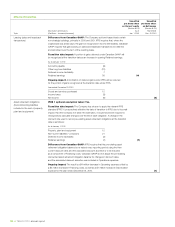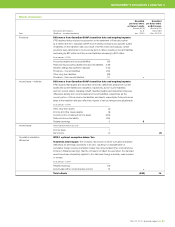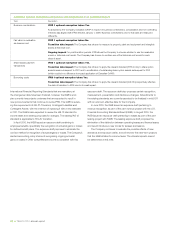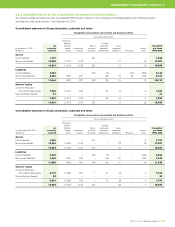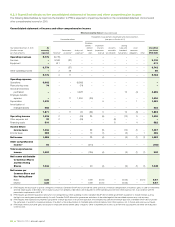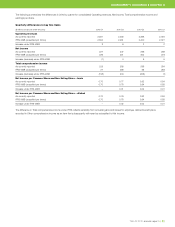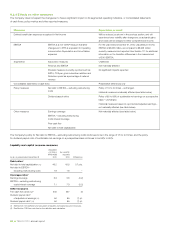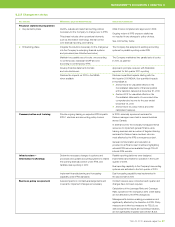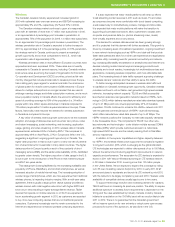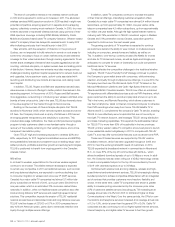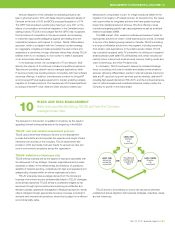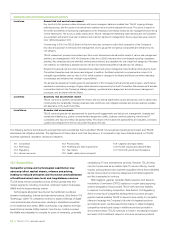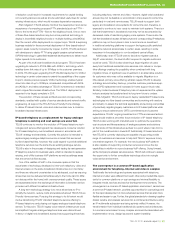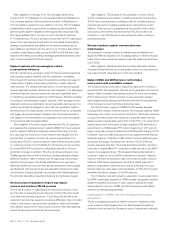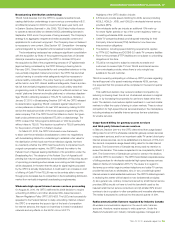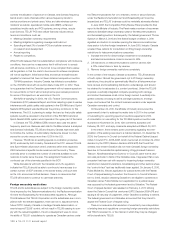Telus 2010 Annual Report Download - page 94
Download and view the complete annual report
Please find page 94 of the 2010 Telus annual report below. You can navigate through the pages in the report by either clicking on the pages listed below, or by using the keyword search tool below to find specific information within the annual report.90 . TELUS 2010 annual report
In addition, cable-TV companies continue to increase the speed
of their Internet offerings, intensifying customer acquisition offers.
Canada’s four major cable-TV companies have almost 5.4 million Internet
subscribers, up from approximately 5.1 million one year earlier, while
telecom companies have 4.3 million subscribers, up from approximately
4.2 million one year earlier. Although the high-speed Internet market is
maturing with 75% penetration in TELUS’ incumbent region in Western
Canada and 73% penetration across Canada, subscriber growth is
expected to continue over the next several years.
The growing popularity of TV anywhere is expected to continue
as customers demand the ability to view content on multiple screens
including on computers, smartphones and tablets, as well as on
TVs. In addition, over-the-top content providers like Netflix for movies
and Hulu for TV shows and movies, as well as Apple and Google, are
anticipated to compete for share of viewership but could complement
traditional carrier TV services.
To help alleviate the competitive challenges in the traditional wireline
segment, TELUS’ Future Friendly Home® strategy continues to position
the Company to grow wallet share with consumers, while enhancing
retention and loyalty through multiple service offerings. In June 2010, the
Company launched new TELUS brands Optik TV (IP TV based on the
Microsoft Mediaroom platform) and Optik High Speed Internet in urban
Alberta and British Columbia markets. TELUS now offers an enhanced
TV experience with differentiated services such as PVR Anywhere, which
gives customers the ability to record and play back shows on up to six
TVs in the home, and Remote Recording, which allows customers to
use their smartphone, tablet or Internet-connected computer to schedule
their PVR recordings when away from home. TELUS Satellite TV in
Alberta and B.C. complements the company’s Optik TV service, enabling
TELUS to more effectively serve households that are not currently on
the Optik TV network footprint, and leverages TELUS’ strong distribution
and mass marketing capabilities. This expands the addressable market
for TELUS TV to more than 90% of households in the two provinces.
TELUS’ primary western cable-TV competitor announced plans to launch
a new residential media hub/gateway in 2011 to compete with TELUS’
Optik TV, and may offer some similar features such as whole home PVR.
These new IP-based services are supported by TELUS’ wireline
broadband network, which has been upgraded throughout 2009 and
2010 to meet the evolving bandwidth needs of customers. In 2010,
TELUS expanded its broadband network in communities in Alberta and
B.C., to cover 87% of the top 48 communities with ADSL2+, which
allows broadband download speeds of up to 15 Mbps or more. In addi-
tion, the Company has also been rolling out a VDSL2 technology overlay
to reach a comparable footprint in the top 48 communities by the end
of 2011 with download speeds of up to 30 Mbps.
Combined with wireline local and long distance, wireless and high-
speed Internet and entertainment services, TELUS is increasingly offering
bundled products to achieve competitive differentiation with an integrated
set of services that provides customers more freedom, flexibility and
choice. At the same time, cable-TV companies have shown a greater
ability to increase pricing as evidenced by the consumer price index
(CPI) of cable and satellite services (including pay TV) increasing at an
average annual rate of 4.4% from 2001 to 2009 (and higher at Shaw
Communications in the West). Over the same periods, the CPIs for com-
munications and telephone services increased at an average annual rate
of 1.2 to 1.3%, which is lower than the general CPI of 2.0%. Cable-TV
companies are also continuing to roll out higher-speed Internet services,
Internet telephony and digital cable-TV services to fuel their growth.
The level of competitive intensity in the wireless market continued
in 2010 and is expected to continue to increase in 2011. The advanced
wireless services (AWS) spectrum auction in 2008 resulted in eight new
potential competitors acquiring spectrum in separate and overlapping
regions, collectively covering most markets in Canada. In 2010, four new
entrants launched or expanded wireless services using portions of their
AWS spectrum coverage, including WIND Mobile, Mobilicity, Public
Mobile and Quebec-based cable-TV company Videotron. Western-based
cable-TV company Shaw has delayed its wireless launch to early 2012
after indicating previously that it would launch in late 2011.
New entrants, with the exception of Videotron in the province of
Quebec, are not expected to build networks in remote or rural areas for
some time, choosing to focus on urban markets and provide extended
coverage for their urban subscribers through roaming agreements. To win
market share, strategies of entrants have included aggressive price dis-
counting, unlimited rate plans, no system access fees and adding points
of distribution. However, these new entrants must also manage various
challenges including significant capital requirements for network build-out
and upgrades, future spectrum costs, upfront costs associated with
launching and distributing new brands and services, and raising invest-
ment capital.
In addition, TELUS, Rogers and Bell have separately branded basic
value services or discount offerings to better position themselves in this
expanding segment. In the summer of 2010, Rogers and Bell became
more aggressive, re-launching or introducing new wireless unlimited zone
brands at lower price points. Late in the year, TELUS also lowered prices
in the value segment of the market through its Koodo service.
Building on the success of Clear & Simple rate plans that TELUS
launched in November 2009, which removed system access and carrier
911 fees, the Company introduced a variety of initiatives in 2010 aimed
at bringing greater transparency and simplicity to customers. This
included data usage notifications, the Clear and Simple Device Upgrade
program to help customers obtain a new handset earlier through a
recovery of the subsidy remaining on their existing device, and a more
transparent cancellation policy.
Given TELUS’ high and increasing exposure to wireless (52% and
58%, respectively, for 2011 targeted consolidated revenue and EBITDA),
strong established brands and consistent focus on leading-edge, value-
added products, profitable subscriber growth and evolving technologies,
TELUS is positioned to benefit from ongoing growth in the Canadian
wireless market.
Wireline
In contrast to wireless, expectations for the mature wireline segment
continue to be modest. The wireline telecom landscape is expected
to remain very competitive in 2011 as traditional services, such as local
and long distance telephony, are expected to continue declining due
to consumer migration to wireless and voice over IP (VoIP) services.
Canada’s four major cable-TV companies had almost 3.7 million tele-
phony subscribers at the end of 2010, up by just under 500,000 from
one year earlier, which is an estimated 31% consumer market share
nationally. In addition, other non-facilities-based competitors also offer
local and long distance VoIP services and resell high-speed Internet
solutions. This competition impacts the erosion of TELUS’ residential
network access lines and associated local and long distance revenues.
TELUS’ total line losses of 227,000 or 5.7% in 2010 compares favour-
ably to North American peers, partly due to enhanced retention and
loyalty through multiple service offerings.


